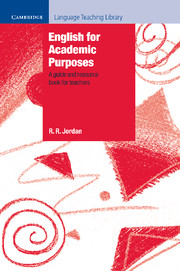Book contents
- Frontmatter
- Contents
- List of figures
- List of abbreviations
- Acknowledgements
- Introduction
- Part I English for Academic Purposes and study skills
- Part II Study skills and practice (EGAP)
- Chapter 9 Academic reading
- Chapter 10 Vocabulary development
- Chapter 11 Academic writing
- Chapter 12 Lectures and note-taking
- Chapter 13 Speaking for academic purposes
- Chapter 14 Reference/research skills
- Chapter 15 Examination skills
- Part III English for Specific Academic Purposes
- Appendices
- References
- Subject index
- Author index
Chapter 11 - Academic writing
Published online by Cambridge University Press: 10 November 2010
- Frontmatter
- Contents
- List of figures
- List of abbreviations
- Acknowledgements
- Introduction
- Part I English for Academic Purposes and study skills
- Part II Study skills and practice (EGAP)
- Chapter 9 Academic reading
- Chapter 10 Vocabulary development
- Chapter 11 Academic writing
- Chapter 12 Lectures and note-taking
- Chapter 13 Speaking for academic purposes
- Chapter 14 Reference/research skills
- Chapter 15 Examination skills
- Part III English for Specific Academic Purposes
- Appendices
- References
- Subject index
- Author index
Summary
As academic writing is so important for students of all kinds, and as it is such a wide umbrella term, it is hardly surprising that there is range of approaches and types of practice for it. Sometimes these depend upon an underlying philosophy, sometimes upon the starting-point of the students, sometimes upon the purpose and type of writing, and sometimes simply on personal preference.
The different approaches in the USA are usefully summarised and put into context by Silva (1990). The starting-point was controlled or guided composition, with its emphasis on the manipulation of language structures and sentence patterns. In Britain, such an approach, based on substitution tables, stemmed from the work of F. G. French, and in New Zealand from H. V. George – both in the 1960s. This led, in general EFL, to books on composition writing making use of substitution tables or writing frames (e.g. Spencer 1967; Moody 1974).
The next major development in the USA was ‘current traditional rhetoric’, in which the central concern was the logical arrangement of discourse forms in the context of the paragraph (e.g. Imhoof and Hudson 1975, in the UK). In Britain, this approach is better known as rhetorical-functional, or simply the functional approach. From an initial concern with sentences and paragraphs, the focus switched to essay development with its structure of introduction, body and conclusion.
- Type
- Chapter
- Information
- English for Academic PurposesA Guide and Resource Book for Teachers, pp. 164 - 178Publisher: Cambridge University PressPrint publication year: 1997



